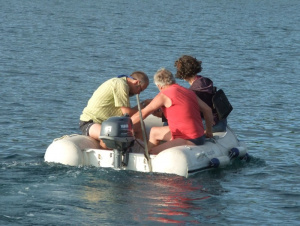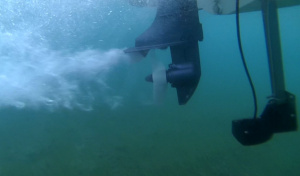OpenSeaMap-dev:HW-logger/Tiefenmesser mobil: Unterschied zwischen den Versionen
Markus (Diskussion | Beiträge) (→Geberstange) |
Markus (Diskussion | Beiträge) |
||
| Zeile 58: | Zeile 58: | ||
; Offset | ; Offset | ||
: 30 cm | : 30 cm | ||
| + | |||
| + | == Weitere Ideen == | ||
| + | : [https://buydeeper.com/press Deeper: a cheep bluetooth Sounder] | ||
| + | : [http://www.airmartechnology.com/uploads/brochures/P66.pdf Airmar P66 preiswertes Echolot für Heckmontage, das direkt NMEA-0183 ausgibt] | ||
| + | |||
| + | == Tips von Airmar == | ||
| + | |||
| + | * Transom mount transducers will not work at any speed if they are installed on a powerboat boat with inboard motors, or any sailboat. | ||
| + | * If you have a single engine outboard, or I/O, make sure that the unit is mounted on the starboard side of the boat, so it is free from most prop wash. | ||
| + | * If you have a twin, or triple engine outboard, or I/O make sure that the unit is mounted between the motors, as low as possible, either on the flat section of the keel (if any), or slightly left or right of the vee. | ||
| + | * If you are still seeing poor performance at speed, this usually indicates that the transducer needs to be mounted lower so that more of the face of the transducer is in contact with the water at speed. | ||
| + | * To make this adjustment, loosen the mounting screws, and slide the transducer 1/2" lower and re-test. You may need to re-drill holes. If you do so, be sure to seal the old holes with manufacturer approved, below the waterline caulking or epoxy. | ||
| + | * You also may want to add another plastic wedge (supplied with the installation kit) so that when looking at the side of the transducer the back or stern of the transducer is noticably lower than the bow or front of the transducer. This angle will not affect depth readings. Doing this adjustmant will help keep the transducer in hard contact with the water at higher speeds. | ||
Version vom 3. August 2014, 15:57 Uhr
Beim Entwicklertörn in Kroatien wurde eine mobile Messeinheit gebaut,
um mit dem Beiboot Flachwassertiefen in Buchten, Häfen und Marinas zu vermessen,
also dann, wenn das Schiff am Anker oder an der Pier liegt.
Inhaltsverzeichnis
Stückliste
| 1 | Echolot | Actisense DST-2 | 135 € |
| 1 | Tiefensensor | Airmar P48W | 90 € |
| 1 | GPS | z.B. Garmin GPSMAP-60 (gebraucht) oder GPS-Maus plus USB>RS232-Wandler |
- 40 € + 10 € |
| 1 | GPS-Anschlusskabel | Garmin-Datenkabel | 25 € |
| 1 | Logger | OpenSeaMap-NMEA-Logger | 40 € |
| 1 | Batterie | z.B. 12V-Mini-AGM-Akku oder alte Motorradbatterie oder Akku von Akkuschrauber |
12 € - - |
| 1 | Geberstange | Eigenbau mit Schraubzwinge | 10 € |
Gesamtkosten ca. 350 €
Geberstange
Die Geberstange haben wir aus einen V2A-Vierkantrohr 20x20 gebaut.
Unten eine Staplatte zur Befestigung des Geber angeschraubt.
Die Stange mit einer Schraubzwinge am Heckbrett des Dinghis festgeschraubt.
Alternativen:
- Professionelle Befestigungsklemme 20 € (Bauanleitung)
- Geberstange mit Klemme 55 € (Bild)
- Halterung des Gebers auf ein "Plastik"-Haushaltsschneidbrett aufschrauben. Mit Sika am Bootsheck dauerhaft befestigen.
- Mobil: Halterung an Saugheber 10 € /Saugnapf befestigen. Plexiglasscheibe am Bootsheck festschrauben oder mit Sikaflex befestigen. Saugnapf hält bestens.
Betrieb
Fliegender Aufbau, Elektronik in zugebundener Plastiktüte, nur Batteriekabel und Sensorkabel schauen raus.
Geberstange mit Schraubzwinge am Dinghi-Heck befestigt. Schraubzwinge und Stange mit Bändsel gesichert damit sie nicht tauchen gehen.
Geber so einstellen, dass er nicht im Schraubstrom der Ausserborder-Schraube liegt (Echolot funktioniert nicht in Luftverwirbelungen).
- Achtung
- Geber ist der tiefste Punkt (nicht die Ausserborder-Schraube!) - Vorsicht also beim Anlegen!
- Geberkabel so an der Geberstange befestigen, dass es nicht in die Schraube gezogen werden kann ;-)
- Offset
- 30 cm
Weitere Ideen
- Deeper: a cheep bluetooth Sounder
- Airmar P66 preiswertes Echolot für Heckmontage, das direkt NMEA-0183 ausgibt
Tips von Airmar
- Transom mount transducers will not work at any speed if they are installed on a powerboat boat with inboard motors, or any sailboat.
- If you have a single engine outboard, or I/O, make sure that the unit is mounted on the starboard side of the boat, so it is free from most prop wash.
- If you have a twin, or triple engine outboard, or I/O make sure that the unit is mounted between the motors, as low as possible, either on the flat section of the keel (if any), or slightly left or right of the vee.
- If you are still seeing poor performance at speed, this usually indicates that the transducer needs to be mounted lower so that more of the face of the transducer is in contact with the water at speed.
- To make this adjustment, loosen the mounting screws, and slide the transducer 1/2" lower and re-test. You may need to re-drill holes. If you do so, be sure to seal the old holes with manufacturer approved, below the waterline caulking or epoxy.
- You also may want to add another plastic wedge (supplied with the installation kit) so that when looking at the side of the transducer the back or stern of the transducer is noticably lower than the bow or front of the transducer. This angle will not affect depth readings. Doing this adjustmant will help keep the transducer in hard contact with the water at higher speeds.







